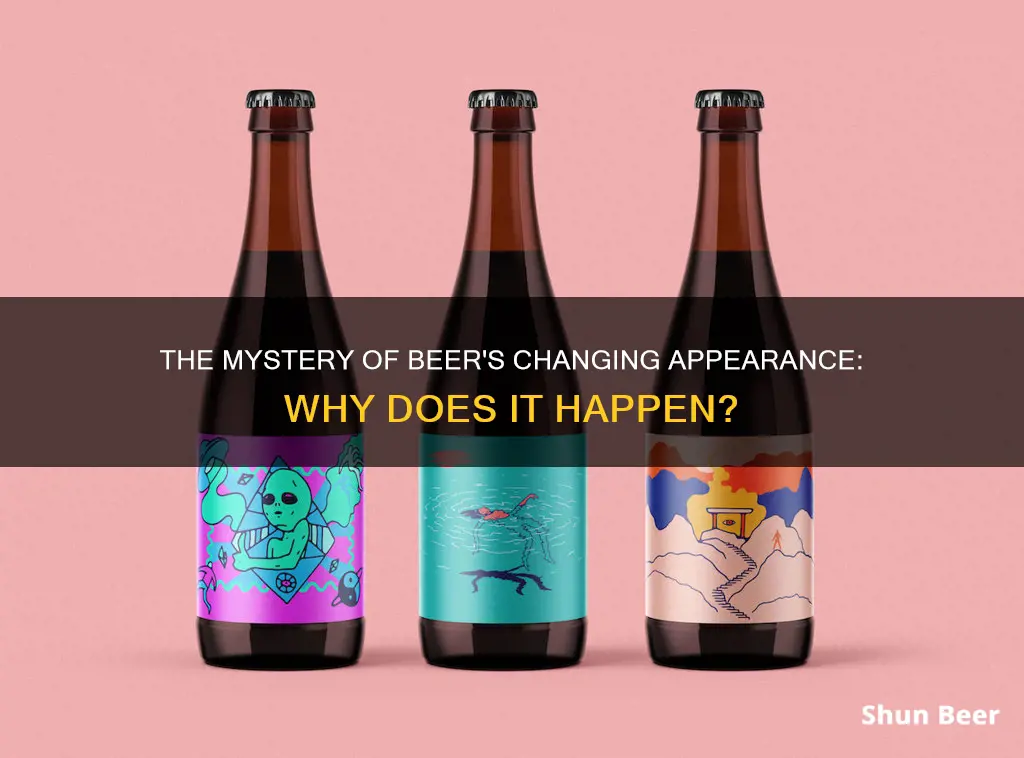
Beer drinkers often notice that the same beer can taste different when served in a variety of glasses or bottles. The temperature of the beer, the type of glass, and the drinking environment can all influence the taste of the beer. For example, beer served too cold can mask flavours and aromas, while warm beer may taste flatter. The shape of the glass can also affect the release and retention of aromatic compounds, impacting the taste and aroma. Additionally, factors such as UV light exposure and the cleanliness of keg lines can also alter the taste of beer. Some people may also have a weaker sense of taste, making it harder for them to distinguish between different beers.
| Characteristics | Values |
|---|---|
| Temperature | A higher temperature allows for more flavours and aromas to come to the forefront, but can lead to a flat-tasting experience. |
| Glassware | The shape of the glassware allows for nucleation sites, temperature control of beer, and aromatic release/retention. |
| Type of Beer | The type of yeast used to ferment the beer determines whether it is a lager or an ale. |
| Drinking Environment | The drinking environment can affect the taste of the beer. |
| Cleanliness of Keg Lines | The cleanliness of the keg lines can impact the taste of the beer. |
| UV Light | UV light can cause a chemical reaction in hops, producing 3-MBT and causing the beer to taste "skunky". |
| Vessel Material | Beer can taste different when drunk from plastic, glass, silver, or tin vessels. |
What You'll Learn

Glassware makes a difference
Glassware makes a huge difference when it comes to serving beer. The shape of the glass can enhance the drinking experience by allowing for nucleation sites, temperature control, and aromatic release/retention. Different shapes and styles of glassware have been developed over the years to enhance the experience of drinking different styles of beer. Some breweries even develop glassware specifically to accompany a certain beer, which is why some bars might have as many styles of glasses as they do styles of beer.
The pint glass is one of the most basic and ubiquitous types of beer glassware. American and European pint glasses differ slightly in size, with the former holding 16 ounces and the latter 20, but they share a similar cylindrical shape with a moderately narrow body that opens up toward the top. This design allows for the release of aromatics and the retention of a large amount of head, making pint glasses suitable for a variety of beer types.
Pilsner glasses are similar to pint glasses but narrower and sloping, designed specifically for pilsner-type beers. Weizen glasses, on the other hand, have a tulip shape at the top and are usually larger, holding up to half a liter of beer. This design plays up the head and flavors of wheat beers. The stange, a German word meaning "rod" or "stick", is a smaller version of the pint glass, resembling a Tom Collins glass. Its delicate shape is ideal for magnifying the flavors of more subtle beers.
Mug-shaped glassware is common in beer-drinking establishments worldwide. Derived from the German beer stein, mugs are designed with durability and insulation in mind. The thick glass and handle make it easier to maintain a grip and prevent the warmth of the hand from affecting the beer's temperature.
Goblets, tulip glasses, and thistle glasses are deeper cuts for beer enthusiasts. These glasses have stems and bulbous shapes that gather and enhance aromatics, as well as allow for swirling and foam retention. They are often used for higher alcohol content beers.
When choosing the right glassware for your beer, it's important to consider factors such as the specific needs of the beer (e.g. the narrow base of a wheat beer glass allows sediment to settle at the bottom, not affecting the taste), ensuring that form matches function (e.g. the thick glass of mugs is designed for durability), and enhancing and retaining the beer's head (e.g. the wide mouth of a goblet maintains the beer's head).
The Many Shades of Blue Moon Beers
You may want to see also

Temperature affects taste
Temperature has a significant impact on the taste of beer. Serving temperature influences the flavour, hoppiness, crispness, and aftertaste of beer.
When beer is served too cold, it masks many flavours and aromas. The cold temperature slows the volatilization of aromatic compounds, causing them to linger in the beer. This can dramatically change the apparent flavour and aroma, sometimes making the beer taste thin and almost tasteless.
On the other hand, warmer beer allows more flavours and aromas to come to the forefront. However, as beer approaches room temperature, sensations from hop bitterness and carbonation can decrease, leading to a flatter-tasting experience.
Additionally, cold temperatures can numb the tongue, dulling strong flavours and hiding weaker ones. Therefore, the ideal serving temperature for beer depends on the specific style and desired taste profile.
For example, American Mainstream Light Lagers are typically served between 33° – 40° F / 1° – 5° C, while Stouts and Porters are recommended to be served at a warmer temperature of 45° – 55° F / 7° – 13° C.
It is worth noting that temperature fluctuations may not have an immediate or significant impact on the flavour of beer. However, repeatedly cooling and warming beer can induce a permanent haze, where proteins and tannins bond to create semi-soluble molecules. While this affects the beer's aesthetics, it does not alter its flavour, aroma, or mouthfeel.
Vodka vs Beer: Different Drunk Feels
You may want to see also

Type of yeast used
The type of yeast used in the brewing process can have a significant impact on the appearance, flavour, and fermentation of beer. Brewers have a wide range of yeast strains to choose from, each imparting unique characteristics to the final product.
Saccharomyces Yeast
The most commonly used yeast in beer production is Saccharomyces, which translates from Latin to "sugar fungus", reflecting its affinity for sugar. Within this genus, the two primary species employed in brewing are Saccharomyces cerevisiae (ale yeast) and Saccharomyces pastorianus (lager yeast).
Ale Yeast (Saccharomyces cerevisiae)
Ale yeast, also known by its Latin name Saccharomyces cerevisiae, is a top-fermenting variety, meaning it rises to the top of the fermenter during the fermentation process. It thrives in a temperature range of 10°C to 25°C, with an ideal range of 18°C to 22°C. Ale yeast is known for its quick fermentation, efficient sugar consumption, moderate alcohol tolerance, and ability to survive anaerobic conditions.
One notable characteristic of ale yeast is its unique flavour production. It produces a range of flavour compounds, including esters and fusel alcohols, which contribute to the fruitiness of the beer. These yeasts are commonly used in brewing ales, stouts, porters, wheat beers, Altbier, and Kölsch.
Lager Yeast (Saccharomyces pastorianus)
In contrast to ale yeast, lager yeast, or Saccharomyces pastorianus, is a bottom-fermenting variety, fermenting at the bottom of the fermenter. It operates in a colder temperature range of 7°C to 15°C. Due to the lower temperatures, lager yeast reproduces more slowly and inhibits the production of certain chemical by-products, resulting in a "cleaner" taste often associated with lagers. Lager yeast is commonly used in brewing Lagers, Pilsners, Bocks, Märzen, and Dortmunders.
Yeast Characteristics Affecting Beer Appearance
Yeast characteristics such as flocculation and attenuation also influence the appearance of the beer. Flocculation refers to the clumping of yeast cells, with high flocculation resulting in clearer beer as the yeast sinks to the bottom of the fermenter more quickly. Attenuation, on the other hand, refers to the degree to which yeast ferments the available sugars, impacting the final clarity and flavour of the beer.
Wild Yeast and Souring Microbiota
In addition to the commonly used Saccharomyces yeast strains, wild yeast and souring microbiota present in the air can also be utilised in spontaneous fermentation processes. This method, similar to sourdough bread making, results in unique flavours and characteristics in the final beer.
Beer Size Matters: How Larger Brews Differ
You may want to see also

UV light changes flavour
Beer is the third most popular drink globally, with an upward trend in production. Beer spoilage, however, remains a common problem for the beer industry. Beer spoilage bacteria can lead to undesirable aromatic compounds, such as diacetyl and hydrogen sulfide, being formed.
Ultraviolet (UV) light can cause a "lightstruck" or "skunky" flavour in beer. This is due to the formation of 3-methylbut-2-ene-1-thiol (3-MBT), a compound with an aroma associated with skunk spray. 3-MBT is formed when UV light interacts with isomerised hop compounds. The light wavelengths that cause this reaction fall between about 350 and 550 nanometers; 350 nm is the upper end of the ultraviolet range (invisible to the human eye) and 550 nm is in the visible range.
The "skunky" flavour can be avoided by blocking UV light from reaching the beer. This can be done by using amber, brown or opaque bottles, or by storing beer in stainless steel containers.
Some beers, such as Corona, retain the skunky flavour, and it has become accepted as part of the flavour profile. Other beers use a stabilised hop extract that does not lead to the production of 3-MBT, so they can be stored in clear bottles.
Sour Beers: A Unique Fermentation Process
You may want to see also

Glass shape affects experience
Glass shape affects the experience of drinking beer in several ways.
Firstly, the width of the rim changes the way the beer is delivered to your mouth. Wide rims allow the beer to rush out of the glass, while narrow rims slow the flow. A wide rim also encourages faster drinking as the beer will go flat.
Secondly, the shape of the glass can affect the speed at which the beer is consumed. A study by the University of Bristol found that beer was consumed faster from a flute glass (which has sides that curve outward) than from a straight glass. This was attributed to the difficulty in judging the halfway mark in a curved glass, which led to faster drinking.
Thirdly, the shape of the glass can influence the perceived taste of the beer. A curved-sided glass, for example, has been shown to make beer taste fruitier and more intense. This may be because people associate fruitiness with curvature.
Finally, the glass's shape can affect the beer's appearance, with certain glasses showcasing the colour, foam head, and carbonation of the beer. For instance, a pilsner glass is tall and tapered, displaying the beer's colour and a comfortable head of foam. Meanwhile, a weizen or wheat beer glass combines a chalice and pilsner glass, with a narrow bottom and a wider bowl that presents the beer's hazy colour and thick foam head.
Beer Drinking: Unique Experience, Different Feeling
You may want to see also
Frequently asked questions
The shape of the vessel you drink beer from can affect the taste and appearance of the beer. The shape of a glass allows for nucleation sites, temperature control of beer, and aromatic release/retention.
Clear and green bottles allow more light in, which can cause a chemical reaction in the hops that makes the beer taste skunky.
Ice-cold beer has less flavor than beer at room temperature.







